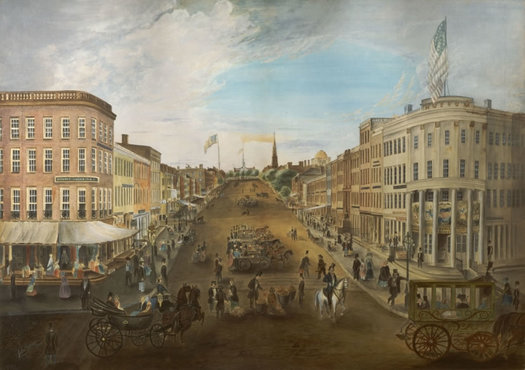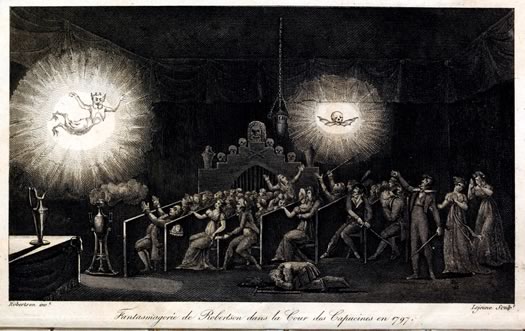The curiosities, sideshows, and phantasmagoria of the old Albany Museum

In this 1848 painting of State Street in Albany by John Wilson, the Albany Museum is on the right in the building with the colonnade. (Head over to the Albany Institute collection for a closer look.) / image: Albany Institute of History & Art
In the early 19th century, Henry Trowbridge and Harry Meech housed more than 200,000 natural and artificial curiosities at their Albany Museum. Life-sized sized wax figures, phantasmagoria shows, cosmorama, magicians, necromancers, lusus naturae, an Egyptian mummy, and traveling sideshows. All could be seen for the price of a quarter.
The museum started in the upstairs in the old city hall in 1809 and eventually moved to a beautifully colonnaded building at the corner of State and Broadway. It was part of a wave of "dime museums" that were sprouting up in cities across the nation.
They mixed amusement with education -- or, at least, what qualified then as education -- and were centers of family entertainment at the time.
Phantasmagoria: Horror theater in the 19th century

E.G. Robertson's depiction of audiences attending phantasmagoria. / image via Wikipedia
One of the Albany Museum's most thrilling exhibitions was a portrayal of the summoning of Samuel by the Witch of Endor at the behest of Saul. The witch would dramatically cast a spell over the tomb of Samuel. Upon the ringing of a bell, the terrifying specter of Samuel would rise slowly from his grave. With a booming voice, the apparition would chastise a horrified Saul (and the audience) for disturbing his slumber. The ghost would prophesy terrible events and then slowly sink back into his tomb to return to his rest. Audiences were thrilled and astounded.
The key to phantasmagoria was the magic lantern. It was a projector, not too different from a modern slide projector. A box was fitted with a lens and a bright kerosene lamp was placed inside. Glass panes with images painted on them were placed into the beam of light to project an image onto a wall, transparent screen, or a puff of smoke. The image was animated by dividing an image onto multiple glass panes. By moving one pane while the base pane remained stationary, the object appeared to come to life.
A modern showing of phantasmagoria at the Museu del Cinema in Girona, Spain
The Albany Museum also provided phantasmagoria that was "particularly arranged for the amusement of young persons." To put parents' minds at ease, the advertisement for the children's show provided examples of what would be seen. The scenes included the cutting off of heads and putting them back on again, rolling out eyes and putting them back in again, comical dancing to music, and the shaving of a pig.
Morrell and his "Cannibal Show"
Dime museum proprietors needed to keep things fresh in order to get customers to return time and time again. The easiest way to do this was to host traveling sideshows for limited engagements. Unique oddities, biological rarities, and "freaks of nature" drew huge crowds. The Albany Museum saw its fair share of these exhibits.
Benjamin Morrell captained the Antarctic on a sealing expedition between 1829 and 1831. Morrell captured -- that is, kidnapped -- two South Pacific natives during the unprofitable expedition. Named "Sunday" (actual name Dako) and "Monday" (actual name unknown), the two were forced to return to New York City with him and the ship. Heavily in debt, Morrell capitalized on the interest of New Yorkers in his travels. He presented a show with an embellished account of his travels and displayed the heavily tattooed men as "South Pacific Cannibals."
After the show ended in New York, Morrell took the act on the road. Their first stop was at the Albany Museum in October 1831. Living in Albany at the time was a 12 year old Herman Melville. It's possible that Dako was real life inspiration for the Moby Dick character Queequeg.
Other famous traveling shows
 Chang and Eng Bunker
Chang and Eng Bunker
The most famous of these visitors were the conjoined twins Chang and Eng Bunker. Chang and Eng were from Siam (now Thailand) and are the origin of the term "Siamese twins." That's a photo of them on the right (image via Wikipedia).
Joice Heth
She was advertised as the oldest woman alive at 161 years. She also claimed to be the nursemaid of George Washington and would spin tales about "dear little Georgie" for the crowds.
The Industrious Fleas
Yes, flea circuses are real. Tiny gold wires were used to harness the fleas around their necks. Fleas that tended to walk would pull things, such as tiny reproduction chariots. Fleas that tended to jump would operate ferris wheels or kick balls.
Signor Antonio, later known as Signor Vivalla
A celebrated "plate and bowl dancer" who performed "feats of equilibrium." His signature move was to balance a sword on the prong of a fork while a bowl was resting on top. After a several week engagement at the Albany Museum, he was poached by a visiting P.T. Barnum who offered him $12 a week.
Afong Moy, "The Chinese Lady"
Afong Moy was billed as the first female Chinese immigrant to America. Crowds were astonished by her lotus feet. Foot binding had caused them to be only 4 â…› inches long.
General Tom Thumb
Tom Thumb began touring with P.T. Barnum when he was only 5 years old. He had stopped growing at 6 months of age and was only 26 inches tall. His act included singing, dancing and was known for an impersonation of Napoleon Bonaparte.
An example of a flea circus from Paris in 1949.
Wax museum
One of the earliest attractions at the Albany Museum were its wax figures. A 1810 newspaper advertisement gives a preview of what could be expected.
+ Daniel Lambert, an Englishman who was famous for his unusually large size. He weighed 739 lbs at the time of his death in 1809.
+ "Tears of America". An angel weeping over the tomb of George Washington.
+ Othello and Desdemona from Shakespeare's tragedy.
+ Jael driving a nail through the temple of Sisera from the Book of Judges.
+ A representation of the late president Ezra Stiles of Yale University.
+ A Native American warrior
+ A small boy who would play the organ "as natural as life".
As time went on more wax tableaux were added. Visitors could see Sir William Wallace, Charlotte Temple, General Andrew Jackson, the Goddess of Liberty, Sleeping Beauty, Tam o' Shanter, Black Hawk, and Louis XIV. There was even a likeness of local villain Jesse Strang, perpetrator of the murder at Cherry Hill.
Fate of the museum and its curiosities
The museum closed rather unceremoniously in April of 1855. The contents of the museum were sold to a "Doc Spalding" to be exhibited as part of a floating circus.
The name undoubtedly refers to Gilbert Spalding, a former pharmacist who once lived in Albany. Spalding fell into the entertainment industry when he obtained the ownership of a circus as payment for a bad debt. It turned out that Spalding had a flair for showmanship and was highly successful as a circus manager. The collection of the museum became part of Spalding & Rogers Floating Palace. It was towed from town to town along the Mississippi River and performances were held on the barge.
According to H.P. Phelps, the wax figure of Jesse Strang had a second life out west as "Murrell, the Western Highwayman."
Henry Trowbridge and Harry Meech now spend most of their time in Albany Rural Cemetery.
Tim Varney is a self-identified history geek who lives in the Center Square neighborhood of Albany. He has also been called a pinball wizard and a duck enthusiast. When he asked his father to describe him for this bio, his father said, "You're my most interesting son."
Hi there. Comments have been closed for this item. Still have something to say? Contact us.
Comments
Great read, thank you!
... said Ron on Oct 3, 2017 at 2:27 PM | link